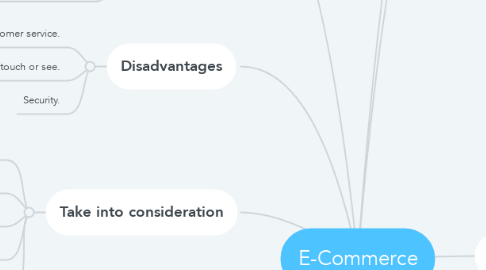
1. What is it?
1.1. Is any commercial activity carried out over the internet
2. Start
2.1. Its beginnings date back to the 1960s. When companies began to use electronic data interchange (EDI)
3. Advantage
3.1. Availability.
3.2. Access speed.
3.3. Wide availability.
3.4. Easy accessibility.
3.5. International reach.
3.6. Lower cost.
3.7. Personalization and product recommendations.
3.8. Facilitates buying and selling.
4. Disadvantages
4.1. Limited customer service.
4.2. Not being able to touch or see.
4.3. Security.
5. Take into consideration
5.1. Network security.
5.2. Program compatibility.
5.3. Investment in the platform.
5.4. Payment Methods.
5.5. Lack of logistics.
6. Categories
6.1. Business to business (B2B).
6.1.1. It is one in which the commercial transaction is only carried out between companies and consumers are not involved.
6.1.2. Advantage.
6.1.2.1. Reduction of costs and expenses.
6.1.2.2. Increased efficiency and productivity.
6.1.2.3. Speed of transaction handling.
6.2. Business to consumer (B2C).
6.2.1. It is one in which companies sell different products, services or information to consumers.
6.2.2. Advantage.
6.2.2.1. Image enhancement.
6.2.2.2. Lower costs.
6.2.2.3. Elimination of intermediaries.
6.2.2.4. Possibility of quick access to different markets.
6.3. Consumer to consumer (C2C).
6.3.1. It is where consumers exchange products, services and information with each other online.
6.3.2. Advantage.
6.3.2.1. Product reuse.
6.3.2.2. purchases at lower prices and with unique offers in the middle.
6.4. Consumer to business (C2B).
6.4.1. It is where consumers make their products and services available online so that companies can offer and buy.
6.4.2. Advantage.
6.4.2.1. Coverage of the needs of millions of users.
6.4.2.2. Wide variety of offers and products in a small space, condensed from the same page.
6.5. Business to Administration (B2A).
6.5.1. It refers to transactions carried out online between companies and the public administration or government organization.
6.5.2. Advantage.
6.5.2.1. Considerable time and effort savings.
6.5.2.2. Availability 24 hours a day.
6.5.2.3. Always updated information.
6.6. Consumer to Administration (C2A)
6.6.1. Transactions between end users and government entities. Such as the payment of social security, tax payment, among others.
7. Success Cycle
7.1. Attract web users
7.1.1. Create
7.1.2. Audience
7.1.3. Advertise
7.1.4. Promote the web
7.2. Generate interest and participation.
7.2.1. Useful and interactive content
7.3. To hold back
7.3.1. Capture and use of information.
7.4. Update content
7.5. To learn
7.5.1. Capture and use of information.
7.5.2. Feedback with users.
7.6. Loyalty
7.6.1. Customize service.
7.6.2. Interaction in real time.
8. It is determined by
8.1. The market
8.1.1. Horizontal
8.1.1.1. If the product is usable in many industries, it is said to have a broad or horizontal business market.
8.1.2. Vertical
8.1.2.1. If the product can be used in practically all companies in one or two industries only, we will say that it has a vertical market of companies.
9. Types
9.1. Direct E-commerce
9.1.1. The object of the transaction is a traditional physical good or product.
9.2. Indirect E-commerce
9.2.1. It is done directly through the Internet. For example: the purchase of software, music, electronic books, movies, among others.
